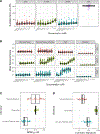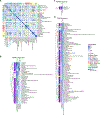High-Throughput Transcriptomics Screen of ToxCast Chemicals in U-2 OS Cells
- PMID: 39159848
- PMCID: PMC11626688
- DOI: 10.1016/j.taap.2024.117073
High-Throughput Transcriptomics Screen of ToxCast Chemicals in U-2 OS Cells
Abstract
New approach methodologies (NAMs) aim to accelerate the pace of chemical risk assessment while simultaneously reducing cost and dependency on animal studies. High Throughput Transcriptomics (HTTr) is an emerging NAM in the field of chemical hazard evaluation for establishing in vitro points-of-departure and providing mechanistic insight. In the current study, 1201 test chemicals were screened for bioactivity at eight concentrations using a 24-h exposure duration in the human- derived U-2 OS osteosarcoma cell line with HTTr. Assay reproducibility was assessed using three reference chemicals that were screened on every assay plate. The resulting transcriptomics data were analyzed by aggregating signal from genes into signature scores using gene set enrichment analysis, followed by concentration-response modeling of signatures scores. Signature scores were used to predict putative mechanisms of action, and to identify biological pathway altering concentrations (BPACs). BPACs were consistent across replicates for each reference chemical, with replicate BPAC standard deviations as low as 5.6 × 10-3 μM, demonstrating the internal reproducibility of HTTr-derived potency estimates. BPACs of test chemicals showed modest agreement (R2 = 0.55) with existing phenotype altering concentrations from high throughput phenotypic profiling using Cell Painting of the same chemicals in the same cell line. Altogether, this HTTr based chemical screen contributes to an accumulating pool of publicly available transcriptomic data relevant for chemical hazard evaluation and reinforces the utility of cell based molecular profiling methods in estimating chemical potency and predicting mechanism of action across a diverse set of chemicals.
Keywords: Computational toxicology; High Throughput Transcriptomics; Signature scoring; U-2 OS.
Published by Elsevier Inc.
Conflict of interest statement
Declaration of competing interest The authors declare no conflict of interest. This manuscript has been reviewed by the Center for Computational Toxicology and Exposure, Office of Research and Development, U.S. Environmental Protection Agency, and approved for publication. Approval does not signify that the contents reflect the views of the Agency, nor does mention of trade names or commercial products constitute endorsement or recommendation for use.
Figures






References
Publication types
MeSH terms
Grants and funding
LinkOut - more resources
Full Text Sources
Molecular Biology Databases

